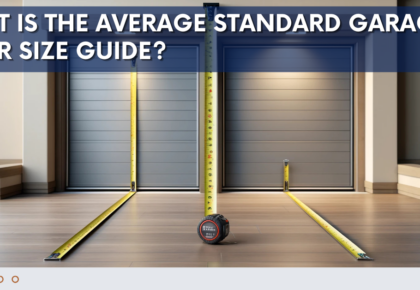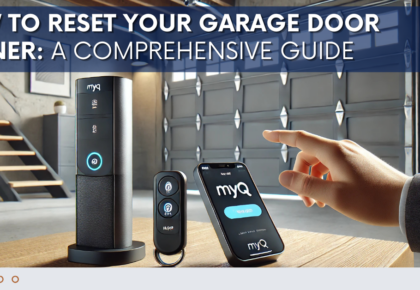Making your garage energy-efficient can help you save money, make your home more valuable, and be better for the environment. Whether you’re building a new garage or fixing an old one, using new materials and technology can make it more energy-efficient. This guide will show you how to do it with better insulation, smart gadgets, and more.
Good Insulation is Important
Insulation helps keep your garage warm in winter and cool in summer. Here are some good options:
- Aerogel Insulation: This is very thin but keeps a lot of heat in. It’s great if you need strong insulation without taking up much space.
- Sheep’s Wool Insulation: This is natural and helps with moisture. It’s good for the environment and works well in damp places.
Expert Tip: Put a vapor barrier on the warm side of your walls. This stops moisture from getting trapped in the insulation, which can cause mold and make the insulation less effective.
Also, insulate your garage floor. Heat can escape through concrete floors, so adding foam insulation with plywood on top can help keep the heat in. This is especially important if you use your garage for work or living space.
Think about using insulated doors between your garage and your house to keep cold air out and improve your home’s energy efficiency.
Choosing the Right Garage Door
Your garage door is a big part of your home, so it’s important to pick one that helps with energy efficiency.
- Vacuum-Insulated Panels: These panels offer great insulation but are thin, so you get good thermal protection without a bulky door.
- Garage Doors with Thermal Breaks: These doors have a special layer that helps reduce heat transfer.
When picking a door, consider the material. Composite doors look like wood but are as strong and efficient as synthetic materials.
Material Insights: For a stylish yet efficient door, look for steel-core doors with a wood-like finish. They look like wood but are strong and efficient like steel.
Check for good sealing. Look for doors with weather seals, like magnetic strips, that fit tightly and stop drafts and moisture from getting in.
Heating and Cooling Solutions
Keeping your garage at a comfortable temperature is important. Here are some efficient options:
- Hydronic Radiant Floor Heating: This system uses hot water in pipes under the floor to keep it warm evenly. It’s great for garages with high ceilings where warm air rises.
- Ductless Mini-Split Systems: These systems can heat and cool different parts of your garage separately. They don’t need ducts and are easy to install.
Cooling Tips: In hot areas, a cool roof can help by reflecting sunlight and absorbing less heat. Pair it with an evaporative cooler or solar-powered air conditioner to save even more energy.
For new technology, try phase change materials (PCMs) in your walls or ceiling. They absorb heat during the day and release it at night, helping to keep your garage at a steady temperature.
Improving Weather-Proofing
Weatherproofing your garage keeps it comfortable and protects your investment. Good weatherproofing stops drafts, moisture, and temperature changes that can damage the garage and make it less efficient.
- High-Performance Weatherstripping and Threshold Seals: These prevent air leaks and are designed to handle temperature changes and frequent use.
- Electronic Threshold Seals: These seals automatically lower when the door closes and lift when it opens, making sure there’s no air leakage.
Weather-Proofing Add-ons: Consider smart glass windows that automatically tint to reduce heat and glare. If your garage connects to your house, storm doors can provide extra protection against the weather and reduce energy loss.
If you live in a stormy area, reinforce your garage door with extra supports to protect it from high winds and reduce damage.

Passive and Active Cooling Techniques
Using both natural and mechanical cooling methods can keep your garage comfortable and save energy.
- Passive Solar Design: Position your garage to use natural shade from trees or buildings and use windows or vents to create airflow and cool the space naturally.
- Reflective or Radiant Barriers: Install these in the attic or roof to reflect heat away from the garage, reducing the need for cooling.
- Thermal Mass Materials: Use materials like concrete or stone in your garage. They absorb heat during the day and release it at night, helping to keep temperatures steady.
Advanced Cooling Solution: A geothermal cooling system uses the earth’s stable temperature to cool your garage. It costs more to install but can save money in the long run and is great for those focused on being eco-friendly.
If geothermal isn’t an option, try a solar-powered ventilation system. These use solar energy to power fans that remove hot air from the garage. Attic fans can also help remove hot air from above the garage.
Building an Efficient Garage Door and More
Adding smart technology to your garage can make it more energy-efficient and convenient. Smart garage doors with Wi-Fi let you control and monitor them from anywhere. They can also close automatically based on your schedule or location, keeping your garage secure and well-regulated.
When renovating or building a new garage, consider smart home systems that connect your garage’s lighting, temperature, and security to a central hub. This makes it easy to control everything and use energy more efficiently.
Design Considerations: Use LED lighting instead of traditional bulbs. LEDs save energy, last longer, and stay cooler. For garages with high ceilings, motion-sensor lights that turn on only when needed can save even more energy.
If your garage connects to your home, use double drywall or soundproofing insulation to reduce noise and improve energy efficiency. Adding water-saving fixtures like low-flow faucets or a small rainwater collection system can enhance sustainability.
For those converting their garage into a guest suite or rental unit, energy efficiency is even more important. Make sure the garage is well-insulated, upgrade to energy-efficient windows and doors, and consider a mini-split HVAC system for precise temperature control.
By using these tips and technologies, your garage can become a model of energy efficiency, comfort, and modern convenience. Whether you want to save on bills, increase your home’s value, or create a more sustainable space, this guide will help you reach your goals.








